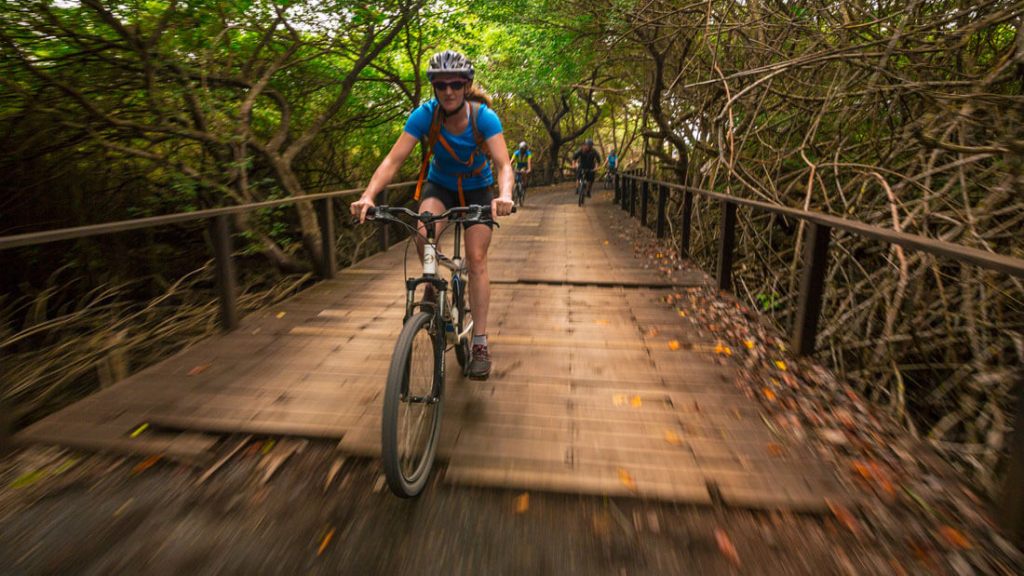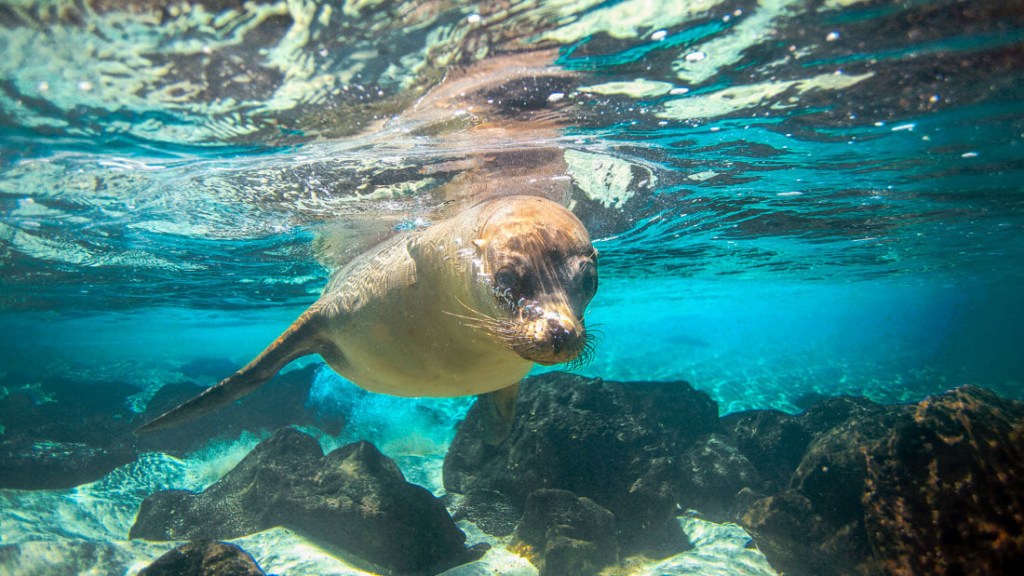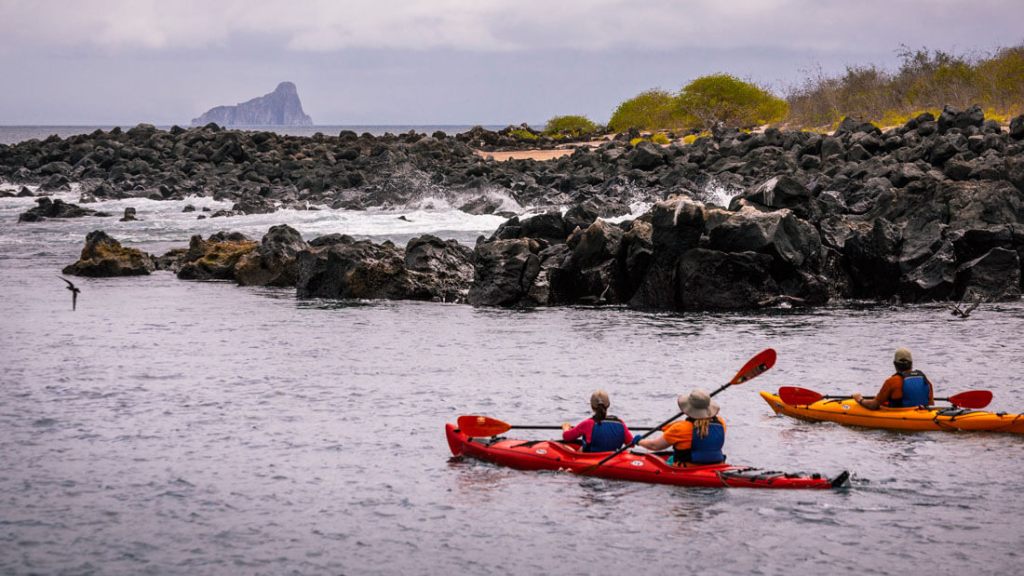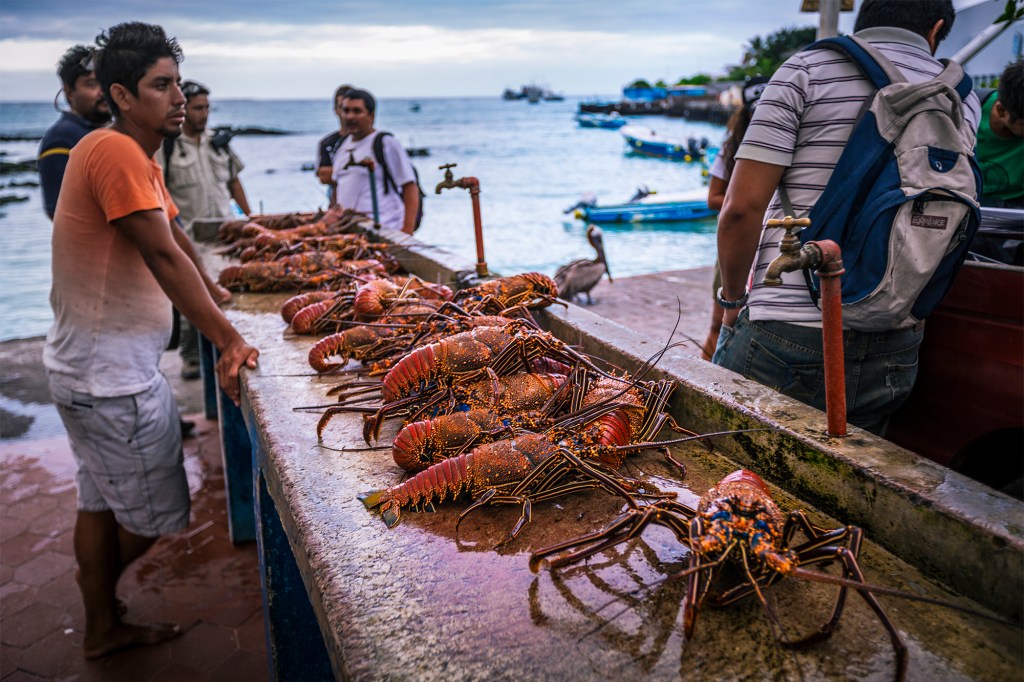About 600 miles off the coast of Ecuador, you’ll find a little corner of paradise: The Galápagos Islands. Sea lion pups nip at your fins as you swim through the warm, equatorial waters. Marine life thrives and underground lava tubes and caves abound. On land, you’ll spot rare animal species, and you can even hike to the top of the world’s second-largest caldera. If you love wildlife, tropical climates and outdoor adventures, a trip to the Galápagos Islands is sure to please.
This guide will cover all the ins and outs of traveling to the Galápagos Islands off the coast of Ecuador, including:
- Why Travel to the Galápagos Islands?
- Top Destinations in the Galápagos Islands
- Top Activities in the Galápagos Islands
- How to Plan Your Trip

Kayakers paddle among massive sea cliffs.
Why Travel to the Galápagos Islands?
If you’re an animal lover, the Galápagos Islands should be on your bucket list. Because the islands are so remote, they play host to a variety of animal and plant species that aren’t seen anywhere else in the world, including the land iguana, the giant tortoise, huge cacti, endemic trees and many types of finches and mockingbirds. According to historical reports, Charles Darwin—impressed by the area’s biodiversity—created his theories of evolution and natural selection after a visit to the Galápagos Islands in 1835.
And the impressive natural displays don’t stop where land meets the sea. The Galápagos Marine Reserve is an underwater wildlife park with some of the most abundant marine life in the world. According to UNESCO: “No other site in the world can offer the experience of diving with such a diversity of marine life forms that are so familiar with human beings, that they accompany divers.”
Located off the coast of Ecuador where three ocean currents meet, the 127-island archipelago is a volcanic hotspot that contains several active shield volcanoes; their frequent volcanic activity leads to vibrant, underwater marine life, according to Oregon State University.
“The reason I would travel for about 24 hours from Seattle to Atlanta, then to Quito, Ecuador … then to Guayaquil before finally arriving on San Cristobal Island … is the amazing wildlife,” says Suzanne Faith Harris, an adventure travel program coordinator. “I was blown away by the diversity. The animals are not hunted by man and have no fear.”
Top Destinations in the Galápagos Islands
While you can visit many of the Galápagos Islands, only a few contain developed infrastructure. Visitors typically stay on a cruise boat that leaves from one of the largest islands, listed below, or on a hotel on one of these islands:
This seahorse-shaped island crossed by the equator is the largest of the Galápagos Islands; at 1,803 square miles, it’s bigger than all of the rest of the islands combined and contains five fully formed, active shield volcanoes, according to the Galápagos Conservancy. On Isabela Island, most locals make their money from fishing, farming and tourism.
Many tourists book hotels in Puerto Villamil, the largest town on the island. Villamil contains white-sand beaches and beautiful lagoons filled with flamingos, pintails and whimbrels, according to the Galápagos Conservancy. Villamil has a small airport for inter-island flights and a number of towns and bars.

A cyclist pedals across Isabella Island to the historic Wall of Tears.
If you’re planning to spend time on Isabela Island, you’ll want to visit the Sierra Negra Volcano; its caldera measures 6.2 miles across from north to south. Visitors also often spend time at the Villamil Lagoons, the Tortoise Center, the Wall of Tears and the Tintoreras. (More on these activities below.)
At 381 square miles, Santa Cruz is the second largest island in the Galápagos but the most populated due to its tempered terrain (fewer active volcanoes) and substantial infrastructure, including a large airport. The island’s nearly 12,000 locals also enjoy Santa Cruz’s paved roads (the longest in the Galápagos, running north-south across the island) and developed towns.
If you visit Santa Cruz, you’ll likely spend some time in Puerto Ayora, a port town that serves as a take-off point for most tours and cruises. Puerto Ayora also has a hospital, banks, post office, radio station and airline office, according to the Galápagos Conservancy. Plus, it has the most hotel offerings in the Galápagos Islands.
If you’re planning to spend time on Santa Cruz Island, you’ll likely be interested in Bellavista, where visitors can go underground into lava tubes; it is also a good starting point for hikes or horseback rides to the top of the island. Lava tubes can also be explored from Santa Rosa, another small farming town on Santa Cruz. While on Santa Cruz, you can also check out the Charles Darwin Research Station, Las Grieta (The Crevices) and El Mirador, a partially collapsed lava tube. (More on these activities below.)
Charles Darwin famously came ashore this island in 1835. It’s smaller than Santa Cruz and Isabela islands but contains most of the government infrastructure for the Galápagos Islands, including the capital city, Puerto Baquerizo Moreno. San Cristobal is known for its fertile grounds, freshwater lake and wildlife viewing.
Fernandina Island (the youngest island in the Galápagos), Santiago Island (known for its lava shoreline), Floreana Island (the longest-inhabited island in the Galápagos), Espanola Island (one of the oldest islands, geologically), Marchena Island (which is quite remote and seldom visited), Santa Fe Island, Genovesa Island (known for its red-footed boobies) and Baltra Island (home to an Ecuadorian military base) are also common day trips for tourists visiting the Galápagos. If you plan to take a cruise during your visit to the Galápagos Islands, you may visit these other islands.
Top Outdoor Activities in the Galápagos Islands
On the Galápagos Islands, outdoor adventures abound. Please note, an authorized Galápagos Park Naturalist must accompany travelers at all times on the islands, which means you must book your trip with a group outfitter that can handle all of the logistics and details for you.
There are many outdoor activities to enjoy, but the following make for a great place to start:
1. Hiking
“The Galápagos Islands are quite regulated, so you will need some sort of guide,” says Kelsey Wenger, REI Adventures program manager. “One of the hikes you can do is to the top of [the Sierra Negra Volcano] on Isabela. It’s incredible.”
Guides may take you to hike on the Sierra Negra Volcano on Isabela Island, which offers gorgeous views of the world’s second largest caldera (according to the Galápagos Conservancy). While visiting the volcano, tourists can also walk on relatively a recent lava flow at Volcan Chico, a fissure of a parasitic cone that erupted 40 years ago.
Popular hikes include the Wall of Tears, a three-hour hike on Isabela Island that leads to a historical site built between 1944 and 1959 by prisoners of the now-defunct penal colony. Along the way, the hike winds through lakes filled with flamingos and beaches covered with iguanas and sea lions.
On Floreana Island, a loop trail offers views over a saltwater lagoon, which is home to Galápagos flamingos.
2. Observing Animals
There are many places to see rare animals on the Galápagos Islands, both in the wild and in conservation centers. If you love turtles, plan to visit the Giant Tortoise Breeding Center on Isabela Island. The center breeds and raises giant tortoises before releasing them into the wild.

Home to the slow-moving Galápagos giant tortoise, the islands are a treasure trove of biodiversity.
The islands’ beaches also make popular destinations for viewing wildlife, including the beach at Tortuga Bay and Garrapatero Beach on Santa Cruz Island. At Cerro Brujo on San Cristobal Island, you’ll likely get a chance to see sea lions and coastal and migratory birds such as blue-footed boobies and pelicans. On Fernandina Island, head to Punta Espinoza, where marine iguanas and penguins are known to gather.
3. Kayaking
Sea kayak enthusiasts will enjoy paddling in the Galápagos Islands because of the gentle weather patterns and beautiful coastal terrain. Many companies lead multiday sea-kayaking tours from island to island; these trips typically include kayaking through lava channels (which Wenger says is a blast), observing wildlife and spending time on the area’s uninhabited islands.
Single-day kayaking tours leave from two places. First, the island of San Cristobal, where you can paddle along the island’s coast, past Carola Beach and into Darwin Bay (where Darwin first began his explorations of the Galápagos). You’re likely to spot sea lions, marine turtles, blue-footed boobies and frigate birds on kayaking trips in this area. Many sea-kayaking trips include snorkeling as well.
Second, kayaking trips may begin from Santa Cruz Island, where you can paddle through Divine Bay and Punta Estrada. This area contains lava channels, which make the water cool and calm. Here look for sea life such as rays and sharks, as well as many species of birds and iguanas.
4. Snorkeling and Scuba Diving
Scuba diving and snorkeling in the Galápagos Islands are spectacular experiences because of the copious volcanic activity in the area. According to Oregon State University volcanologists, hydrothermal venting from underwater volcanoes can allow bacteria to coat rocks, which provides an extra food source for shrimp, crabs and barnacles. This hydrothermal venting can also make water temperatures warmer, which allows sea life to grow quickly. Many explorers come to the Galápagos just to dive, and the activity is available year-round.

A seal swims through the tropical Galápagos waters.
You’ll probably need a wetsuit from June through December, when the water is a bit colder (around 72 degrees). From January through May, the water is warmer, averaging roughly 76 degrees, according to the Galápagos Conservancy. As is the case on land, a guide is necessary to properly explore the waters around Galápagos. The Galápagos National Park Directorate (GNPD) only grants permission to a select number of tour providers for underwater exploration, so plan to book your trip in advance and make sure your outfitter is authorized to operate before booking.
For on-land aquatic play, aim to visit Las Grietas, a canyon on Santa Cruz Island filled with crystal clear water and fish. Cerro Brujo Beach on San Cristobal Island is a lovely place to go swimming and snorkeling, and divers will get a chance to see manta rays, turtles, fish and sharks off the coast of Cerro Brujo, too.
How to Plan Your Trip
When to Go
The Galápagos Islands are located on the equator, so there’s really no bad time to visit, Wenger says. “The same animals are there year-round!”
June through December tends to be cooler and drier, while January through May tends to be warm and wet, according to the Galápagos Conservancy. Peak seasons are from mid-June through early September, and mid-December through mid-January. No matter when you choose to visit, though, it’s never really “too cold” to explore the Galápagos Islands, with temperatures hovering around 70-85 degrees. January through May brings brighter wildflowers and the animal-watching bonanza of mating season; June through December brings plankton-rich water perfect for scuba diving and bird viewing.
How to Get There
Wenger recommends flying from the U.S. to one of mainland Ecuador’s two major airports: in Quito or Guayaquil; then taking a smaller inter-island flight to Santa Cruz Island the next day. Flights depart daily from both Guayaquil and Quito.
Most flights will bring you to San Cristobal or Baltra Island. When you arrive in Ecuador, you’ll need to buy a $20 transit card. When you land in the Galápagos, you’ll be required to pay the National Park Entrance fee ($100 for adults, $50 for children), too, all in cash at the airport. Also note: You’ll need to provide proof of medical insurance to enter the Galápagos Islands. Specifically, your coverage should apply to travel outside of your home country. Contact your insurance company to ask for documentation.
Please note, Quito is at a high altitude (9,350’), which means you may experience some mild altitude sickness symptoms when walking its steep streets and sleeping there overnight, such as headache, insomnia and nausea. (See more details from the CDC about sleeping at high elevations here.)
Transportation Between the Islands
There are ferries between the major islands, or you can choose to sleep on a cruise ship, which will ferry you between all of the places you’d like to explore. There are ports on each of the main populated islands where you can catch a high-speed or local ferry, including:
- Santa Cruz de la Palma or Puerto Ayora on Santa Cruz Island
- Puerto Baquerizo Moreno on San Cristobal
- Puerto Villamil on Isabela
Ferries usually depart twice daily, according to Galápagos Transfers, and the travel time is approximately two hours. The main ferry operators are Naviera Armas and Fred Olsen Express. Public ferries typically cost $25-$35 USD, per person per ride. High-speed ferries vary in cost and are typically more expensive. You can buy tickets through a travel operator or in town at kiosks near the ports.

Exploring the Galápagos by paddle is a great way to check out the archipelagos’ overlooked details.
You can also take an inter-island flight, available daily, between the three main populated islands of Santa Cruz, San Cristobal and Isabela.
Money
Because the official currency of Ecuador is the U.S. dollar, you can use the American currency on almost every island, according to Wenger. Major credit cards will work in the more touristy areas but, as with most trips, Wenger recommends bringing some cash just in case.
“We advise $350 to $400 for meals for eight days,” Wenger says. “Everything is expensive.” Tip: Get your cash before you land in the Galápagos Islands—you’ll have to buy a Transit Control Card for $20 and a National Park Entrance Pass for $100 at the airport, and both are cash only.
Where to Stay
There are two options for accommodations on the Galápagos Islands. You can stay at a hotel on one of the three inhabited islands, Isabela, Santa Cruz and San Cristobal, and take day trips to the other islands by boat each day; or you can stay on a liveaboard cruise boat, which will allow you to travel to the other islands more easily. If you choose to stay in a hotel, it will likely cost less, but be slightly less convenient. On the other hand, cruises can be pricier, but you’ll probably see more.
“I have done a land visit [staying in hotels] and a cruise which moves between the islands while you sleep,” Harris says. “I loved the cruise—hands down, I saw more of the Galápagos and its fascinating wildlife, both on land [walking and hiking] and by water [panga boat, snorkeling].”
As the Galápagos Islands are heavily regulated, there are very few camping options. If possible, you should book your Galápagos accommodations well in advance or as part of a guided tour. You’ll also be required to show proof of your hotel or cruise reservation in the immigration office at the airport.
What to Pack
If you plan to fly between the islands at any point (and this includes your flight from Quito to Santa Cruz), Wenger recommends packing light: the inter-island flights have a checked luggage weight restriction of 20 pounds per person, and a carry-on weight restriction of five pounds per person.
You should bring a daypack for excursions, big enough to hold a water bottle, a jacket, sunscreen, a camera and some snacks. Ecuador and the U.S. use the same 120 voltage plug socket, so you won’t need a converter.
Food
“This area is well known for seafood,” Wenger says. “Corn and rice and beans are also common staple dishes on the islands—and you’re on the equator—so there’s fresh fruit year round.”

Hungry? Seafood is par for the course in the Galapagos Islands.
Use bottled water, not tap, when on the islands.
Internet Access
Plan to be offline for most of your trip. All internet in the Galápagos is satellite-based, so it may be tough to get a signal and you’ll probably have to pay extra for it. Most hotels have telephones.
Useful Phrases
Spanish is the official language on the Galápagos Islands. However, English is spoken in most major tourist hubs. Useful Spanish phrases to remember include:
- Yes: Si
- No: No
- Hello: Hola
- Goodbye: Adios
- Thank you: Gracias
- How much?: Cuanto cuesta?
- Do you have…?: Tienes usted…?
